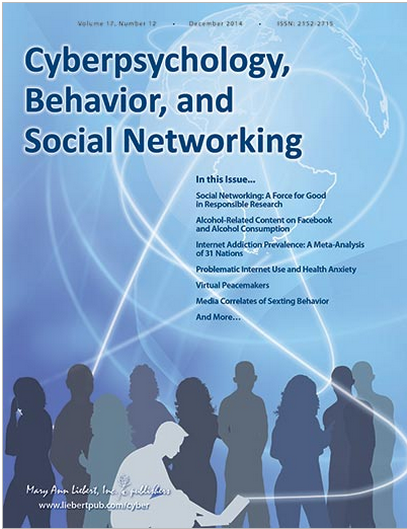2011 Spring Editorial
Journal of CyberTherapy & Rehabilitation
Spring 2011, Volume 4, Issue 1
EDITORIAL
There is an emerging body of literature about the proliferation of social networking sites (SNS) and their effects on mental health. To date, much of it has focused on investigating the possible negative effects of SNS, such as Internet addiction. However, research also supports the benefits of SNS in mental health, addictions, stigmatized identities, trauma and violence recovery, and grief support. As clinicians and researchers, we are just beginning to harness the power of SNS to promote mental well- being.
Participation in SNS has increased dramatically over the past five years. A 2010 Pew report showed that 73% of online teens and 47% of online adults in the U.S. used SNS. Another survey conducted by Pew in April–May 2010 noted that Poland, Britain, and South Korea are close behind the U.S. in SNS usage, followed by France, Spain, Russia, and Brazil. Lower participation in other countries is due primarily to less-wired populations. No table exceptions are Germany and Japan, where Internet usage is high but SNS usage is low.
The European Union has been investing in e-Health since 2004, when outgoing Public Health and Consumer Protection Commissioner David Byrne said, “We need a … Europe where people have easy access to clear and reliable information on how to be in good health and about diseases and treatment options.” An outgrowth of the European Parliament hearing at which he testified was the creation of the ICT (information and communication technologies) for Health, enabling health service providers in different EU member states to work together to exploit these technologies. More recently, the First International E-Mental Health Summit in Amsterdam in 2009 organized by the Trimbos Institute in collaboration with the International Society for Research on Internet Interventions attracted 500 participants from more than 40 countries. In the U.S., the new healthcare reform law provides financial incentives for providers to use health information technology and electronic health records, and in March 2011 leaders in healthcare technology will share their innovations in San Diego and San Francisco, California for the Health 2.0 conference.
In one such innovation, a researcher used a GPS-enabled phone and a location-aware SNS to design a system to help trainees with cognitive impairment who felt lost to find a nearby caregiver. These individuals were enrolled in a supported employment program that provided them with a job coach to help them get to and from work for the first few weeks. The system was programmed to send text messages to the job coach and time and location alarms to help the trainee get to work on time. This type of SNS could enable parents, guardians, and caregivers to watch loved ones unobtrusively.
A recent study of 217 college-age participants in South Korea found that SNS network size was positively related to subjective well-being, and the results suggest that this is due to self-disclosure. In the SNS context, it is postulated that the positive association with well-being results from the self-disclosure “confession effect,” the expectation of mutual self-disclosure, and the expectation of social support.
A case study report found that deploying the Three Good Things positive psychology exercise as a Facebook ap- plication was viable, with a 1% dropout rate, which is similar to or better than other online wellness applications. In the exercise, people post three good things that happened, along with the reasons they think they happened. People found that sharing with others and viewing other’s posts were valuable, as long as they were able to choose which comments they made were public and which were private.
Specialized health SNS such as PatientsLikeMe and DailyStrength offer emotional support, social support, and
patient empowerment; some also offer physician Q&A, quantified self-tracking, and clinical trials access. PatientsLikeMe includes support for mental disorders such as anxiety, bipolar affective disorder, depression, obsessive-compulsive disorder, and Posttraumatic Stress Disorder; DailyStrength provides support for an even broader array of mental health issues. In an online SNS, inhibitions may be lowered, anxiety may be lessened, and anonymity may be increased. This presents the ideal 24/7 support for treatment of people with disorders such as depression. Indeed, the Pew report showed that teens look online for health information about issues they find are embarrassing to talk about such as drugs, sex, and depression.
Of course, there are cautions. One study found that people with depression who used an online SNS spiraled down if they had friends who were moderately or severely depressed and had a negative opinion of the SNS. The researchers concluded that the SNS could be helpful if people take a break from it if their posts elicit these reactions.
A position paper on pervasive healthcare concludes that “[provided-designed systems and services] should include help for people to access peer-to-peer social support sharing and caring in order to encourage sustained engagement with self management to build positive healthy identities for themselves.” Online health consumers are beginning to rely on “patient opinion leaders” for advice on chronic conditions such as mental disorders, and we need to be there with them. Of course, we must be mindful of issues such as privacy and data accuracy as we create tools to help SNS participants balance their needs to share information with their needs to manage self-presentation. Nonetheless, as clinicians and researchers, we should take advantage of SNS to extend the practice of evidence based medicine and mental health.
Brenda K. Wiederhold, Ph.D., MBA, BCIA
Editor-in-Chief, Journal of CyberTherapy & Rehabilitation
Virtual Reality Medical Institute

